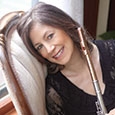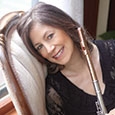Every day I start my warm-up with a few moments of inspiration. Have you ever forgotten your concept of sound, lost your low register, or felt low-energy and uninspired? I certainly have. I find that hearing even a few moments of recordings of some of my favorite great performances has an almost magical, instantaneous effect on me. I make subconscious physical changes, energizing my sound because of the concept now in my mind. I become more aware of making a musical line and of spinning my vibrato.
Performances which inspire me include Julius Baker’s Poem by Charles Griffes, Marcel Moyse’s Humoresque by Antonín Dvorák, Fenwick Smith’s Madrigal by Philippe Gaubert, William Bennett’s Sonata by Mel Bonis, Jean-Pierre Rampal’s and Julius Baker’s Andante et Rondo Opus 25 by Franz Doppler (on Cavett) and more recent recordings such as Lorna McGhee’s Largo by J.S. Bach, Mimi Stillman’s Canzone by Samuel Barber, and Greg Milliren’s Chaconne by Sigfrid Karg-Elert. I am also inspired by great violinists. One of my favorites is David Oistrakh playing Clair de Lune by Claude Debussy. One of the many wonderful singers that inspire me is Renee Fleming in, for example, Song to the Moon by Dvorák. After hearing one of these miraculous performances (available on Youtube), I am itching to pick up my flute!
Sonority Warm-ups
My teacher, Marcel Moyse, showed me these warm-ups which are variants of the exercises in his book, De La Sonorite.
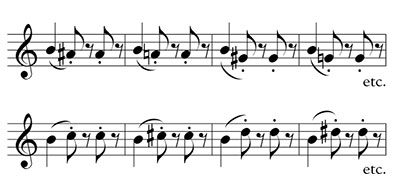
These warmups were a lifesaver for me the day that our orchestra flight was delayed, so that we had to go directly to Carnegie Hall with ten minutes to spare before the concert. After ten minutes of playing these exercises up and down the flute range, I felt ready to go on stage.
Daily Exercises
Every day I practice several pages from an exercise book, such as the classic Grands Exercises Journaliers de Mecanisme by Taffanel and Gaubert, with special emphasis on the famous #4. I try to keep my fingers relaxed and close to the keys and focus on the pleasant sensation of barely moving my fingers, as though the weight of each finger is sufficient to close the key. As an alternative to this book, I move to Exercises Journaliers by Marcel Moyse, Daily Exercises by Julius Baker, Sequences by Geoffrey Gilbert, and The Flutist’s Vade Mecum by Walfrid Kujala.
Scales
On day one, I practice all of the major scales, on day two, all of the harmonic minor scales, and on day three, all of the melodic minor scales, repeating this pattern every three days with a variety of articulations. I once heard the great Geoffrey Gilbert (teacher of James Galway) say that practicing scales without going into the very high register is a waste of time. I like to practice scales starting on the lowest tonic note within the flute range, going up to the highest note in the scale within the flute range, as in high C# or D. Then I go down to the lowest note in the scale within the flute range, as in low C or B. I end back on the lowest tonic within the flute range.
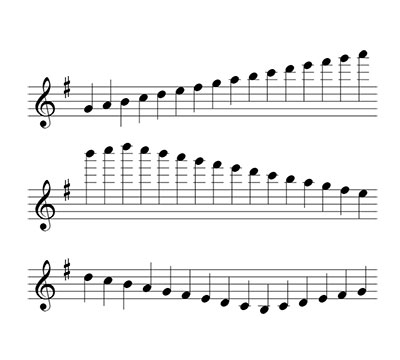
I also like to practice scales in patterns which I make up, such as:
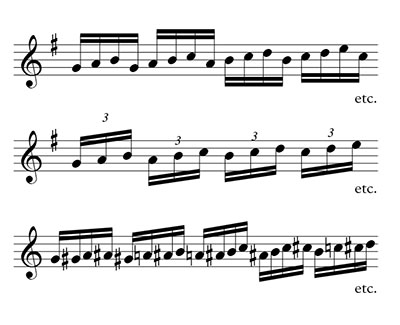
I practice these with a variety of articulations, and going into the extreme high and low ranges of the flute.
I also practice scales in triple-tongued triplets, such as:
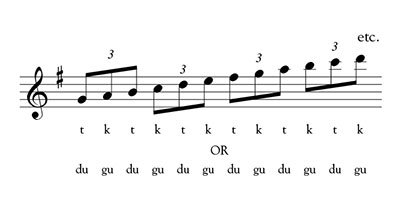
(Jean-Pierre Rampal commented that a fluency in triple tonguing scales is a sign that you’re really in shape!)
Double Tonguing
I practice the following three excerpts every day, which Julius Baker recommended for building up and maintaining double tonguing speed and endurance: J.S. Bach’s Sonata in C Major, Movement 2 Allegro, Camille Saint-Saens’ Volieres from Carnival of the Animals, and Felix Mendelssohn’s Scherzo from A Midsummer Night’s Dream – two measures before letter P to the end.
Melodies
I play a melody or two from Marcel Moyse’s Tone Development Through Interpretation. Moyse transcribed these melodies, mostly vocal arias from operas which he heard performed by great singers in early twentieth-century Paris such as Enrico Caruso, Amelita Galli-Curci, Luisa Tetrazzini and Nellie Melba. Moyse felt that the singers had a stronger tradition of phrasing, expression, emotion and color than he did as a flutist, so he wrote down and practiced the melodies he heard them sing and used them to try to develop these traits in his own (and subsequently his students’) playing. As I work on one of these melodies, I feel my embouchure waking up. I aim for the flexibility to change the color, crescendo and diminuendo, and play softly especially in the high register without going out of tune.
Upcoming Repertoire
I really dislike cramming. I much prefer the luxury of learning technical passages over a long period of time. For this reason, I keep a pile of the solo and chamber pieces that I will be playing during the coming year on my music stand. In my first half hour of practice, (before I get to the music, I have to work on for next week’s orchestra concert), I work on just the most technical passages from each piece, slowly and in different rhythms. For example, right now I am working on Valerie Coleman’s Fanmi Imen and Robert Beaser’s Variations. I single out the hardest runs and technical passages and use them as warm-ups.
For instance, I have really put time into the quick, tongued quintuplet section of the Beaser starting in measure 4/4, which I find quite tricky. Over a period of several months it is really starting to improve. I also keep in mind the most challenging orchestral repertoire I will be playing in the coming season. In this case, I will be playing Prokofieff’s Classical Symphony and Peter and the Wolf, so I play the hardest parts from these pieces from memory pretty much every time I pick up my flute.
I remind myself to practice most what I cannot play, rather than what I can already play. I love to practice because I love the sound of the flute. In whatever mood or color or effect I am attempting to create, I always strive to find greater beauty in the sound, and that pursuit makes me happy. As Marcel Moyse used to say, Avec plaisir! or Play with pleasure!
